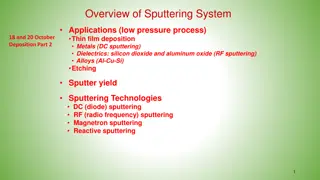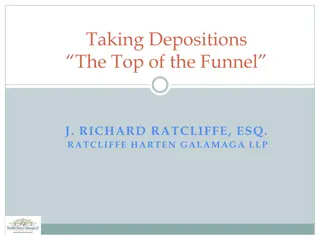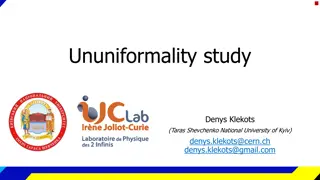Brain Mineral Deposition and Cognitive Decline Study
Investigating the progression pattern of brain mineral deposition as a differential indicator of cognitive decline in individuals with varying cognitive statuses from normal to Alzheimer's disease. The study aims to develop improved imaging techniques and specific cognitive-relevant atlases to under
4 views • 24 slides
Atomic Layer Deposition Equipment Market Size, Trends, Forecast Research 2032
The global atomic layer deposition equipment market size was USD 3.9 Billion in 2023 and is projected to reach USD 9.2 Billion by 2032, expanding at a CAGR of 10% during 2024\u20132032.
0 views • 4 slides
Chemical Agents Awareness Training Overview
This training module covers standardized awareness and authorized training on chemical agents, including toxic industrial chemicals, riot control agents, and chemical warfare agents. Participants will learn about the physiological signs/symptoms, advantages/disadvantages of using chemical agents for
1 views • 20 slides
Chemical Deposition Techniques in Solid State Physics
Chemical deposition is a fabrication technique using different chemicals for reactions, allowing coatings to form successfully. Techniques include spray pyrolysis, electrochemical deposition, dip coating, and more. Spray pyrolysis, cost-effective and versatile, is used in various commercial processe
1 views • 25 slides
Enhancing Chemical Formula Writing Skills for Students
This action research focuses on improving students' ability to write and name chemical formulas. The study addresses challenges in understanding and applying chemical concepts in a general chemistry course. Strategies include utilizing worksheets, group collaboration, and mobile applications to enha
2 views • 13 slides
Understanding Amyloidosis: Causes, Types, and Pathological Characteristics
Amyloidosis is a disorder characterized by the deposition of abnormal amyloid fibrils in tissues, impacting various organs. This condition is associated with different types of amyloid, such as AA and AL amyloid. The deposition of amyloid can lead to tissue damage and organ dysfunction. Primary and
1 views • 11 slides
Understanding Chemical Kinetics: Rates of Reactions and Factors Influencing Them
Chemical kinetics delves into the speed of chemical reactions and the factors that influence reaction rates. This field explores how collisions between atoms, ions, or molecules drive chemical reactions, as well as the role of catalysts, reactant concentration, temperature, and surface area. By unde
0 views • 32 slides
Understanding Sputtering Systems for Thin Film Deposition
Sputtering systems, including DC and RF sputtering, are used for thin film deposition of metals, dielectrics, and alloys. This process involves ejecting atoms from a solid target material through bombardment by energetic particles. The efficiency of sputtering is measured by sputter yield, which dep
0 views • 35 slides
Physical Vapor Deposition Market
The Global Physical Vapor Deposition Market size is expected to be worth around USD 7 Billion by 2033, from USD 3.2 Billion in 2023, growing at a CAGR of 8.1% during the forecast period from 2024 to 2033.\nClick here for request a sample : \/\/market
1 views • 4 slides
Understanding Earth's Landforms: Erosion, Deposition, and Weathering
Explore the processes of erosion, deposition, and weathering that shape Earth's landforms over time. From the breakdown of rock through weathering to the movement of eroded material by erosion and the settling of sediments by deposition, witness the continuous transformation of Earth's surface. Disc
1 views • 14 slides
Understanding Arthritis: Diagnosis and Pathophysiology
Joint pain can result from various factors such as inflammation, cartilage degeneration, crystal deposition, infection, or trauma. Different pathophysiologic processes necessitate clinical evaluation and identification through history, physical examination, and understanding of joint disease types.
2 views • 49 slides
Enhancing Synergies for Resilient Tomorrow: Chemical Waste Management Project Overview
Enhancing Synergies for a Resilient Tomorrow outlines a project aimed at strengthening the Federated States of Micronesia's capacity in chemical management. The project focuses on monitoring and evaluating chemical use, enhancing legislative frameworks, and establishing a central database for chemic
1 views • 12 slides
Understanding Chemical Effects of Electric Current
The chemical effects of electric current involve reactions in conducting solutions through which an electric current passes. This phenomenon leads to various effects like electroplating, formation of gas bubbles, deposition of metals, and changes in solution color. Conductors play a vital role in al
5 views • 17 slides
Global Physical Vapor Deposition Market
The Global Physical Vapor Deposition Market Size is Anticipated to Exceed USD 60.06 Billion by 2033, Growing at a CAGR of 8.40% from 2023 to 2033.\n\n
0 views • 8 slides
Chemical Vapor Deposition (CVD) Methods for Nanomaterials Characterization
Chemical Vapor Deposition (CVD) is a widely used method in the field of nanomaterial synthesis, particularly for growing nanotubes, nanowires, and nanoparticles. The process involves decomposing a gaseous precursor on a substrate with the help of a catalyst, either predeposited or provided in the ga
3 views • 8 slides
Field Sedimentology: Methods and Tools for Sedimentary Studies
Sedimentology involves interpreting sediments and rocks in terms of transport and deposition processes, distribution in space and time. Field studies require basic equipment like a notebook, hand lens, compass, clinometer, hammer, and GPS. Palaeocurrent indicators provide evidence of flow direction
0 views • 28 slides
Overview of Physical Vapor Deposition (PVD) Techniques in Thin Film Deposition
Physical Vapor Deposition (PVD) includes various vacuum techniques for depositing thin films on substrates through physical means. This method involves a dry vacuum process to coat objects with different materials. PVD processes utilize methods like Mechanical, Evaporation, Sputtering, Ion plating,
0 views • 31 slides
Study on MgO Deposition Using (CpEt)2Mg and H2O
Investigation conducted in April 2014 on MgO deposition process using (CpEt)2Mg and H2O. Initial attempts showed non-uniformity, with subsequent optimization leading to uniform deposition on MCPs. Thickness measurements taken on Si and MCPs revealed reproducible results with slight depletion in prec
0 views • 8 slides
Overview of Chemical Reactor Design and Operation
Chemical reactor design involves studying the rates and mechanisms of chemical reactions, as well as the design of reactors for these reactions on a commercial scale. This field combines principles from thermodynamics, chemical kinetics, fluid mechanics, mass transfer, heat transfer, and economics t
0 views • 12 slides
Exploring Fused Deposition Modeling (FDM) Technology
Fused Deposition Modeling (FDM) is an additive manufacturing technology developed in the late 1980s. This process involves laying down molten material in layers using a heated nozzle, making it ideal for prototyping and production. Stratasys, Inc. is a market leader in FDM technology, offering vario
1 views • 14 slides
Understanding Erosion and Deposition Processes in Geology
Explore the dynamic forces of erosion and deposition in geology, from the constructive and destructive processes to weathering, erosion agents, rates of erosion, sorting of sediment, deposition, and different depositional environments where sediments settle. Delve into how factors like weather, clim
0 views • 12 slides
Understanding Erosion, Deposition, Weathering, and Mass Movement in Geology
Explore the processes of erosion, deposition, weathering, and mass movement in geology. Learn about how rocks are broken down and carried away, the different types of weathering, and the factors affecting these processes. Discover the role of gravity in erosion and the impact of chemical reactions o
0 views • 18 slides
Wind as a Geologic Agent in Shaping Landscapes
Wind has played a significant role in shaping landscapes during times of drier climates, being a key geologic agent impacting erosion and deposition processes. The global wind system, driven by factors such as heating from the sun and the rotation of the Earth, creates convection currents that circu
0 views • 31 slides
Understanding Chemical Changes and Reactions
Explore the concepts of chemical and physical changes, including balancing chemical equations, physical properties, and examples of chemical reactions. Learn to distinguish between physical and chemical changes through visual aids and learning checks.
0 views • 24 slides
Understanding Sedimentology: An Overview of Sedimentary Processes and Rocks
Sedimentology is the study of modern sediments like sand, mud, and clay, along with the processes involved in their deposition. Sedimentologists use this knowledge to interpret Earth's geologic history through sedimentary rocks and structures. Sediment plays a crucial role in enriching soil with nut
0 views • 27 slides
Understanding Aeolian Processes and Erosional Landforms
Aeolian processes, driven by wind, shape landscapes through erosion and deposition. This presentation by Pranati Manna explores wind erosion methods like deflation, corrasion, and attrition, as well as transportation and deposition mechanisms. Aeolian landforms, including deflation basins, mushroom
0 views • 19 slides
Understanding Coastal Processes: Erosion, Deposition, and Human Impact
Coastal processes involve a complex interplay of erosion, deposition, and human activities that impact the dynamic equilibrium of coastlines. Energy from tides, waves, wind, and currents shape the land-water interface, while human use of coasts introduces conflicts leading to unstable systems. Sedim
0 views • 44 slides
Mastering the Deposition Process for Legal Professionals
Discover the ins and outs of taking or defending depositions with expert advice on preparation, questioning techniques, and maximizing the deposition experience. Learn why depositions are crucial in building a strong legal case, uncovering new information, and testing theories. Gain insights into us
0 views • 15 slides
Understanding Physical and Chemical Changes in Science Class
Explore the concepts of physical changes and chemical reactions in this interactive science lesson. Students will differentiate between the two types of changes, identify evidence for each, categorize examples, and discuss key concepts with their peers at the table. Through videos and discussions, t
0 views • 21 slides
ASU EHS & FSE Chemical Approval Process Guidelines
Detailed guidelines and forms for the chemical approval process at ASU, including links to important resources, forms for new chemical purchases and transfers, responsibilities for lab managers, and procedures for chemical transfers. The process involves completing forms such as the Prior Approval A
0 views • 5 slides
Understanding Chemical Reactions in Daily Life
Understanding chemistry, particularly chemical reactions, is crucial for our daily lives. Chemical reactions involve the transformation of substances into different ones, described by reactants and products in equations. By learning about chemical equations, word equations, formula equations, and th
0 views • 15 slides
Understanding Obesity: Risk Factors, Fat Deposition, and Hormonal Control
Obesity is a condition characterized by excess body fat accumulation, impacting overall health and increasing the risk of various complications such as diabetes, heart disease, and cancer. This content delves into defining obesity based on BMI, exploring anatomic and biochemical differences in fat d
0 views • 12 slides
Understanding Ionic Bonding and Lattice Energy in Chemistry
Chemical bonds play a crucial role in holding atoms together in molecules. This course explores the concept of chemical bonding, focusing on ionic bonds and lattice energy. Topics covered include the different types of chemical bonds, such as electrovalent and coordinate bonds, as well as the models
0 views • 22 slides
Understanding Biological Changes with Light or Heavy Forces Application
Tooth movement can be categorized as physiologic, pathologic, or orthodontic, with forces transmitted through the tooth to the periodontal ligament and alveolar bone. Changes occurring due to light and heavy forces result in bone resorption and deposition, impacting the supporting structures. Histol
0 views • 25 slides
Strategies for Defending Insurance Company Depositions
Explore key issues and successful strategies for defending insurance company depositions in this comprehensive primer. Learn about pre-deposition considerations, effective defense tactics, and case precedents to enhance your preparation and approach. Gain valuable insights from legal experts to navi
0 views • 20 slides
Texas Ecoregions: Effects of Weathering, Erosion, and Deposition
Texas is divided into various ecoregions each with unique characteristics impacted by weathering, erosion, and deposition. Piney Woods, Western Gulf Coastal Plain, Grand Prairie and Plains, Edwards Plateau, Rolling Plains, and Western and Eastern Cross Timbers are discussed in terms of their soil ty
0 views • 12 slides
Best Practices for Chemical Hygiene and Safety in Laboratories
Responsibilities of the Chemical Hygiene Officer (CHO) include implementing the Chemical Hygiene Plan (CHP), monitoring the chemical life cycle, arranging staff training, conducting safety inspections, assisting staff, and maintaining records. Principals and Science Department Heads support staff in
0 views • 18 slides
Understanding Aeolian Processes and Landforms
Aeolian processes are crucial in arid and semi-arid regions, involving erosion, transportation, and deposition by wind. Factors like wind velocity, grain size, rock composition, and vegetation influence erosion. Different types of wind erosion include deflation, abrasion, and attrition. The transpor
0 views • 18 slides
Study on Energy Deposition in Ununiformality Simulation by Denys Klekots
Simulation study by Denys Klekots at Taras Shevchenko National University of Kyiv focuses on energy deposition in a detector with non-uniform distribution of primary hits. Results show a linear growth in error on energy measurement with non-uniformity and differences in efficiency maps between 1 GeV
0 views • 17 slides
Understanding Deposition Ethics in U.S. District Court
Explore the case of Kelvey v. Coughlin, a medical negligence matter, which sheds light on deposition ethics in the U.S. District Court of Rhode Island. The case involves guidelines on conducting depositions, proper behavior for attorneys, and the consequences of discovery abuse. Learn about the dos
0 views • 29 slides







































